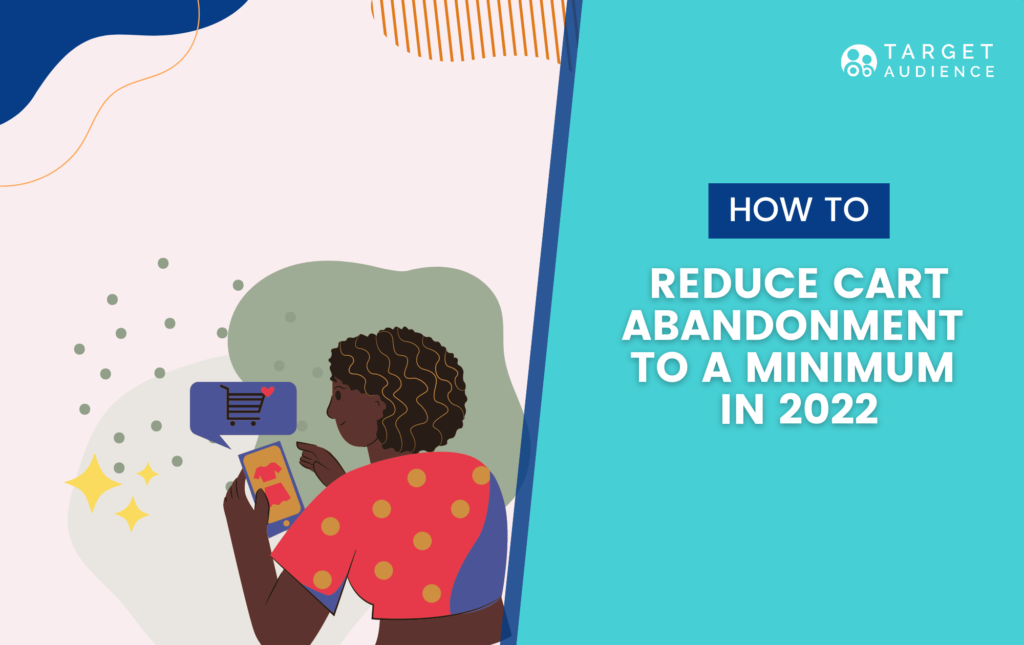Have you ever nearly purchased something online, added the product to your cart, but then for some reason departed at the last minute without completing the transaction? That’s called cart abandonment, and it’s a big problem for ecommerce retailers.
The average abandonment rate varies by industry, but it is generally highest in the travel and hospitality industries, where it can be as high as 89%. For online retailers, the average abandonment rate is traditionally estimated at about 70%. In 2021, however, that number spiked to 80%. As a result of the coronavirus pandemic, more people are shopping online than ever before. According to Tidio’s customer experience survey, 45% of shoppers browse several ecommerce sites and compare prices before making any purchase.
The good news is that while cart abandonment rates are getting higher, so is the average order value. It’s harder to catch the fish, but when you manage to do it, the reward is even higher than before. So how can you tackle the issue of cart abandonment in an increasingly competitive market? In this article, we’ll cover common reasons why customers abandon shopping carts and go over 9 strategies to prevent cart abandonment.
Top Reasons for Cart Abandonment
From a business perspective, the reason why cart abandonment is problematic is pretty self-explanatory. If an estimated 70% of customers who place an item in their shopping cart never complete their purchase, that means that for every $300 a retailer earns, they lose an average of $700 due to shopping cart abandonment. In short, cart abandonment is a problem for businesses because it costs them money. Ecommerce stores miss out on sales and revenue, which eventually impacts their bottom line.
The most common reasons why customers abandon their carts include:
- Customers are just browsing and aren’t ready to buy
- Complicated checkout process
- No social proof or testimonials from other shoppers
- No trustworthy or secure payment options
- Poor website usability on mobile devices
- Hidden or surprisingly high shipping costs
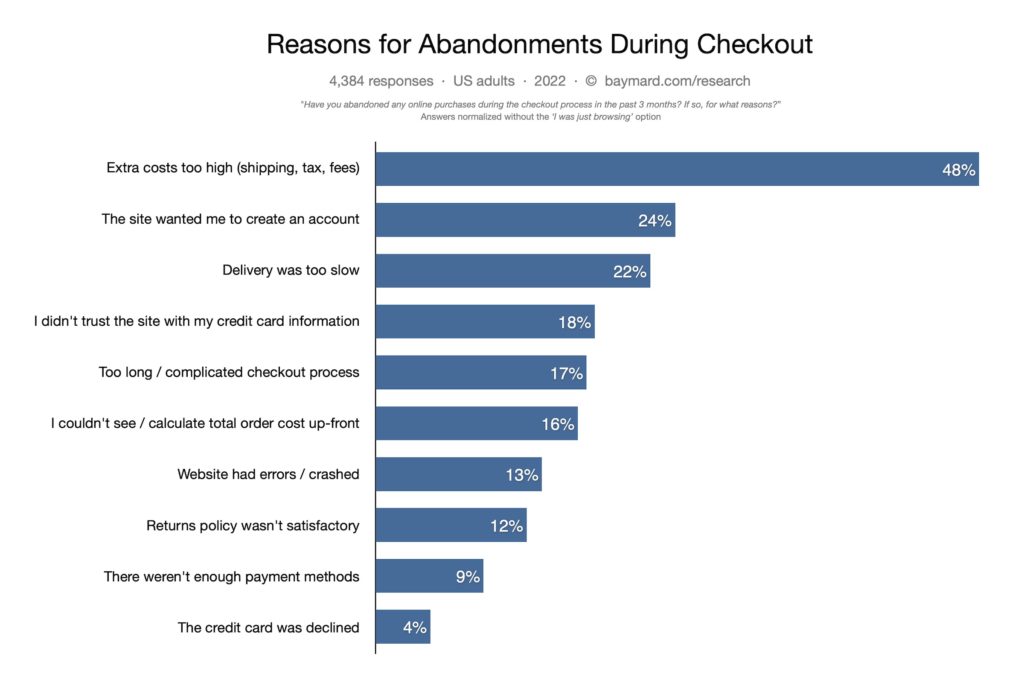
9 Strategies To Reduce Abandoned Cart Rate
1. Transparent regarding extra costs
A major reason for cart abandonment is unexpected extra costs, such as shipping fees, which are only revealed at checkout. Such an unpleasant surprise can be very frustrating for a customer who has just spent time browsing through your online store. Understandably, it can drive them to drop off without completing the purchase.
To combat cart abandonment, be transparent about all additional costs and shipping prices by displaying them as early as possible in the buyer journey. It’s also a good idea to create a dedicated page detailing all potential shipping costs and fees as well as the return policy, as we advised in our product page optimization guide.
2. Email Retargeting
Email retargeting is a common and effective tactic to reduce cart abandonment. Cart abandonment emails sequences usually look like this – the first email is sent 3-4 hours after an order was abandoned, reminding customers about the products they left behind. Then a second reminder is sent after 24h, and the third email goes out after 48h.
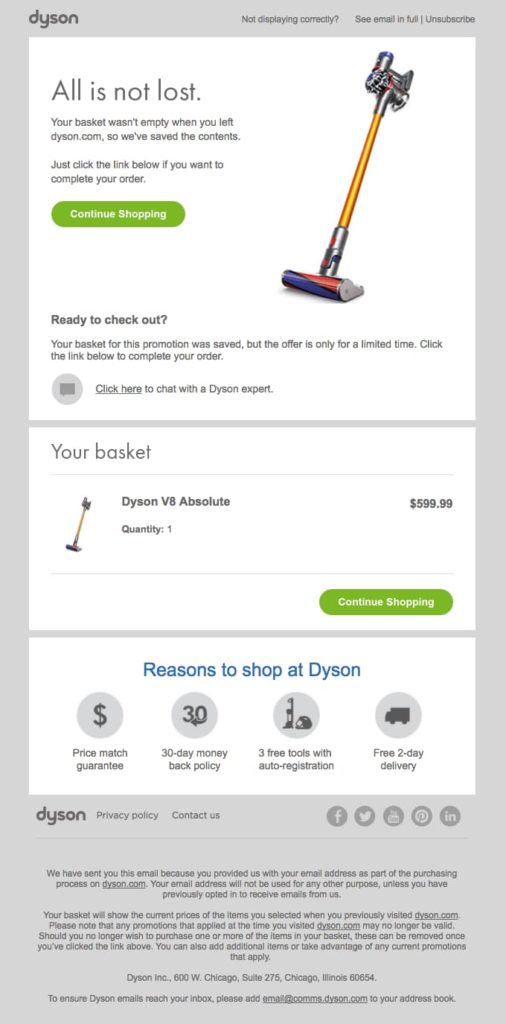
You can include links to encourage the customer to go back on the site and complete the purchase, and even offer them a discount. The open rate for cart abandonment emails is relatively high – the first message in the sequence can get an open rate of about 63%. The click-through rate, however, tends to be much lower. According to Klaviyo’s Ecommerce Benchmark Report, you can expect about 14% of recipients to go back on your website, and about a 10% increase in the total number of completed transactions.
3. Retargeting Ads
Even if you can’t retarget a user through their email, you can still use Google ads and social media to run a retargeting campaign. You know how you browse the internet for an ironing board, and the next day you see ironing board ads on almost every webpage you visit? Those are retargeting ads and they tend to perform well. On average, retargeting ads are 76% more likely to be clicked on than a regular display ad.
However, it’s important to be intentional with your retargeting efforts. Paid advertising can be costly, and retargeting campaigns should be precise and related to products that customers already had in their shopping cart.
4. Exit Detection
Exit-intent pop-ups are one of the most dependable techniques to prevent shopping cart abandonment. It’s a technology that can be installed on any page, and as the name suggests, it detects when a user displays leave behavior. It then sends an overlay message (i.e a pop-up) that encourages customers to stay by offering them a discount code or a coupon, like 10% off their purchase or free shipping.
Exit-intent technology allows you to make one last-ditch effort to convert visitors before they leave your site. It’s critical, however, to use this technology delicately and base it on a database of customer behavior; otherwise, it could come off as pushy and irritating to customers.

5. Chatbot Service
If you’re not sure why your customers are abandoning their carts the best way to find out is by simply asking them. If a customer does not complete their purchase you can trigger an automated chatbot, asking them what’s their reason for leaving.
Another way to utilize chatbots to reduce the number of abandoned carts is by using them to provide real-time assistance. Chatbots can answer customer questions, explain costs such as shipping fees or offer help with finding certain productד. It can help convince customers who are on the fence regarding a purchase and make them feel more satisfied with their experience.
6. Live Chat
Taking the chatbot one step further, you could offer your customers real-time assistance from a human representative via live chat. Communicating with your customers in real-time, answering their questions, and helping them through the checkout process can be very effective at reducing cart abandonment.
Live chat is available on most ecommerce platforms. There are also a number of reliable live chat software providers out there, like HubSpot, Olark, and more. For brands that have a strong social media presence, it’s a good idea to use Facebook live chat integration to connect your live chat and social media.
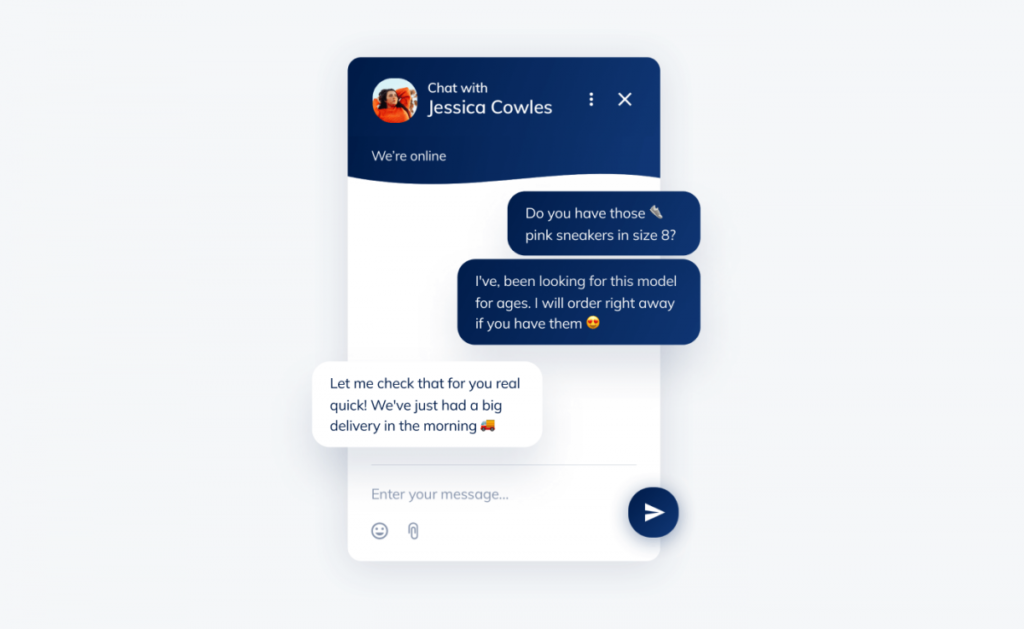
7. Seamless Navigation Between Products and Cart
According to a research study by Baymard Institute, almost 41% percent of all abandonments are due to checkout issues. Thereby, reducing cart abandonment rates is directly related to improving user experience and the checkout flow on your site.
Oftentimes, your site visitors won’t complete their purchase because they can’t find or add that one extra item they need. It may sound funny, but sometimes a customer won’t buy a $500 laptop if they can’t find a $20 mouse to go with it. Instead, they will buy it from a store that immediately suggests the complimenting items they need. That’s why top online retailers like Amazon mastered the art of suggesting additional products.

If the customer can’t find what they want in the suggested items, make sure they can easily navigate between products and cart. Provide an easy-to-edit cart: add a thumbnail to every product with the feature of changing the quantity, deleting it completely, or saving it for later. Use clear and concise product page descriptions, menus, and navigation bars, to help users know where they are on your site so they can easily find what they need.
8. Payment Options
Accepting multiple forms of payment has become the standard, especially for larger ecommerce sites. By providing shoppers the ability to choose the payment method that feels the safest and most convenient to them, you will make checking out much more attractive. Here are two popular payment options you can add to your site:
- Shopping apps or digital wallets – Some customers prefer using digital wallets such as PayPal, Stripe, Venmo, Apple Pay, or Google Pay over using their credit card.
- By now, pay later (BNPL) services – BNPL services like Klarna and Afterpay saw an incredible boom in the last couple of years, and the growth trajectory continues to grow by the month. Globally, deterred payment purchases are expected to exceed 1$ trillion by 2025. Adding this option to your ecommerce store will not only cater to customer preferences, but it’s also likely to boost AOV.
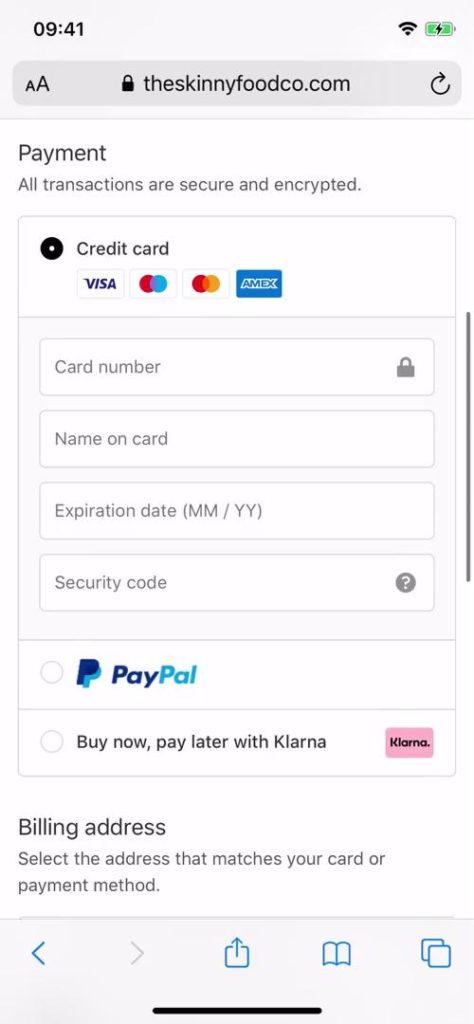
9. Guest Checkout
Requiring customers to create an account before checking out is an unnecessary barrier to purchase, which is likely to increase your cart abandonment rate. This is particularly true for first-time shoppers who are not yet familiar with your brand.
Remember, the checkout flow should be as simple and frictionless as possible. Give shoppers the option to check out as a guest. If you still want to encourage them to sign up for an account, you can do so on the thank-you page. Offering some incentive, like a discount code for their next purchase, can be helpful.
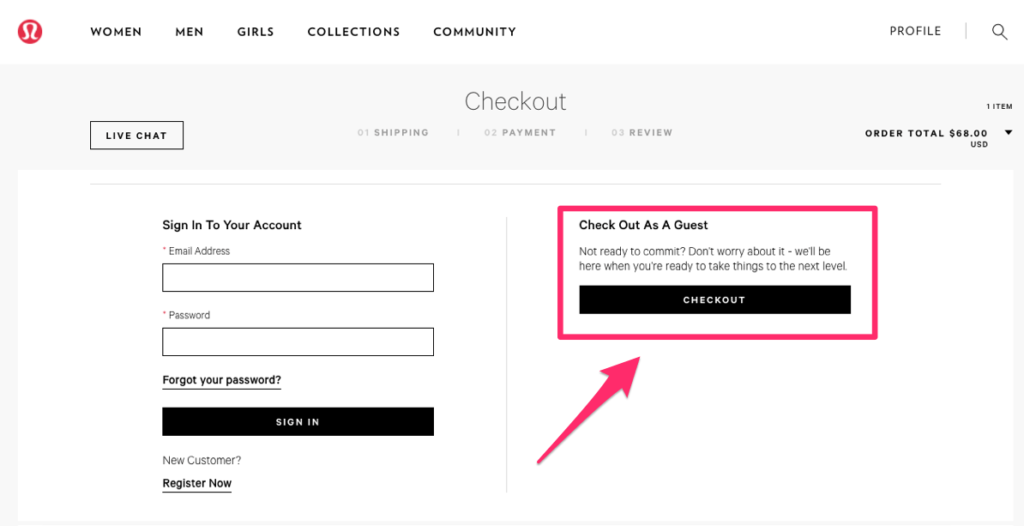
Final Thoughts
Unfinished checkouts are a major problem for online retailers because they lead to lost sales and revenue. While it’s impossible to eliminate cart abandonment completely, with the right set of marketing and customer service tools, you can definitely reduce it. To improve your cart abandonment rate you could:
- Offer live chat or chatbot assistance to increase customer satisfaction.
- Offer discount codes through exit detection pop ups.
- Set up retargeting campaigns on Google and social media to bring back lost customers.
- Accept a veriety of payment options.
- Clarify pertinent information early on – don’t wait till the final stage to inform shoppers about shipping fees and any other additional charges.
- Optimize your desktop and mobile user experience.
Investing in external marketing efforts, such as ad campaigns and influencer partnerships is important, but few strategies will be as effective as finding ways to convert customers who have already made it to the end of the customer journey on your site.


